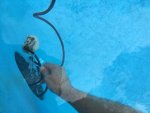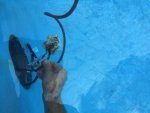- Dec 26, 2016
- 37
- Pool Size
- 15000
- Surface
- Plaster
- Chlorine
- Salt Water Generator
- SWG Type
- CircuPool RJ-45 Plus
I had new Hayward Pool Light (non LED) installed last year. Shortly after, I noticed a streak of rust stains appearing above the light. The streak is easily cleaned with Vitamin C powder in a sock and being doing that every two - three weeks. I finally removed the light from the Niche to see what was going on behind the light. I noticed that there is an extra thick black wire that ends in what looks like a rusted terminal that is covered with a blob of some type of hard white compound. The terminal is not connected to anything. It's just floating free within the niche. The rust is definitely coming from this terminal which is partially protruding from the white compound.
I'm going to call the pool repair company that installed the light, but before I do, want to make sure I understand what is normal and how this wire is supposed to be configured in the niche. I'm also wondering if the rust is due to some electrical current running through this extra wire.
Any thoughts on what is going on and how this should have been set-up?
Thanks!
I'm going to call the pool repair company that installed the light, but before I do, want to make sure I understand what is normal and how this wire is supposed to be configured in the niche. I'm also wondering if the rust is due to some electrical current running through this extra wire.
Any thoughts on what is going on and how this should have been set-up?
Thanks!



